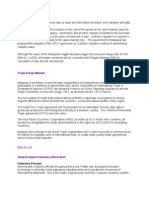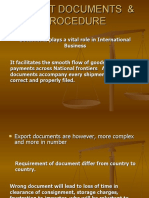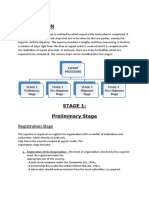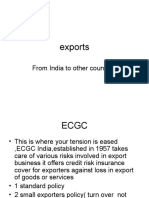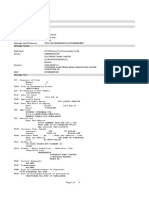0 ratings0% found this document useful (0 votes)
66 viewsExport Process in Colombia
Export Process in Colombia
Uploaded by
Frank QuinteroThis document outlines the key steps and requirements for exporting goods from Colombia. It discusses why exporting is important for Colombia's economy, and covers the basic aspects such as creating a company, registering as an exporter with relevant government agencies, selecting export markets, and obtaining necessary approvals and certificates. It then describes the customs procedures for exporting goods, required export documents, and receiving payment in foreign currency. Overall, the document provides a comprehensive overview of the export process in Colombia.
Copyright:
© All Rights Reserved
Available Formats
Download as PPTX, PDF, TXT or read online from Scribd
Export Process in Colombia
Export Process in Colombia
Uploaded by
Frank Quintero0 ratings0% found this document useful (0 votes)
66 views23 pagesThis document outlines the key steps and requirements for exporting goods from Colombia. It discusses why exporting is important for Colombia's economy, and covers the basic aspects such as creating a company, registering as an exporter with relevant government agencies, selecting export markets, and obtaining necessary approvals and certificates. It then describes the customs procedures for exporting goods, required export documents, and receiving payment in foreign currency. Overall, the document provides a comprehensive overview of the export process in Colombia.
Copyright
© © All Rights Reserved
Available Formats
PPTX, PDF, TXT or read online from Scribd
Share this document
Did you find this document useful?
Is this content inappropriate?
This document outlines the key steps and requirements for exporting goods from Colombia. It discusses why exporting is important for Colombia's economy, and covers the basic aspects such as creating a company, registering as an exporter with relevant government agencies, selecting export markets, and obtaining necessary approvals and certificates. It then describes the customs procedures for exporting goods, required export documents, and receiving payment in foreign currency. Overall, the document provides a comprehensive overview of the export process in Colombia.
Copyright:
© All Rights Reserved
Available Formats
Download as PPTX, PDF, TXT or read online from Scribd
Download as pptx, pdf, or txt
0 ratings0% found this document useful (0 votes)
66 views23 pagesExport Process in Colombia
Export Process in Colombia
Uploaded by
Frank QuinteroThis document outlines the key steps and requirements for exporting goods from Colombia. It discusses why exporting is important for Colombia's economy, and covers the basic aspects such as creating a company, registering as an exporter with relevant government agencies, selecting export markets, and obtaining necessary approvals and certificates. It then describes the customs procedures for exporting goods, required export documents, and receiving payment in foreign currency. Overall, the document provides a comprehensive overview of the export process in Colombia.
Copyright:
© All Rights Reserved
Available Formats
Download as PPTX, PDF, TXT or read online from Scribd
Download as pptx, pdf, or txt
You are on page 1of 23
PROCESO DE EXPORTACION EN
COLOMBIA
María Camila Mejía Moreno
Instructora
Franklin Quintero Ocampo
Aprendiz
WHY IT IS IMPORTANT TO EXPORT IN
COLOMBIA
• There are many reasons to export, including taking
advantage of comparative advantages and the opportunities
of expanded markets through preferential agreements, the
need to be involved in the world market due to the
globalization of the economy and to seek greater profitability
in international markets. But there is a fundamental one: we
export in order to be able to import. And although it may
sound tautological, the country that does not generate the
foreign currency to be able to buy abroad will simply not have
enough to pay for its essential imports.
BASIC ASPECTS OF EXPORTING
• Creation of a company
It is advisable, although not mandatory, that you
incorporate as a company to legitimize the activity
of exporting Colombian goods. By virtue of the
above, the Bogota Chamber of Commerce,
through the Business Services Model, offers you
advice and support to create, formalize and
consolidate your company.
• Registration as an Exporter
Before the tax and customs directorate nationals
-DIAN-: According to the current legal provisions
(Decree 2788 of 2004, Minhacienda), any
company or natural person that is going to export,
must obtain a Unique Tax Registration -RUT- that
qualifies it before the DIAN; in addition, it will be
obliged to operate under the Common Regime, for
which it will be assigned a range of invoicing
codes.
• Before the Ministry of Industry and Commerce
(MINCIT):
The exporter must register in the Foreign Trade
Single Window -VUCE- (Computer system that
integrates the process of authorizations, permits,
certifications and approvals required by the
Colombian authorities for exports and imports), for
which he must: Previously acquire your digital
signature in Certicámara
(https://web.certicamara.com/productos-y-
servicios/certificados-de-firma-digital/).
• With this signature, the Mincit will give you a user and password
to access the VUCE www.vuce.gov.co In this window, through
the Single Foreign Trade Form -FUCE-, exporters can carry out
some procedures associated with a tariff subheading (Register
of National Producers, electronic processing of prior export
authorization, access to government entities related to the
management of approvals, simultaneous inspection system).
• Market selection
If you wish to know about the potential of
your product in international markets, it
is advisable to research the
characteristics of the foreign market:
country demand, basic economic
indicators (prices, exchange rate,
inflation, imports and exports),
commercial customs, competition,
access conditions, international
negotiation terms (Incoterms),
international physical distribution,
current commercial agreements, trends
and tastes. All this in order to minimize
risks and make decisions with certainty
regarding potential buyers.
• Registration for determination of origin and Certificate of
Origin
Tariff exemptions or reductions granted in the
negotiations of free trade agreements require the
issuance of a Certificate of Origin to enjoy these
preferences. The development of this procedure requires
previously filling out an Affidavit of Determination of
Origin (one form for each product), via www.dian.gov.co,
Customs Management module, outgoing goods. Once
the Affidavit is completed, the respective Certificate of
Origin will be requested, a document required by the
customs of the destination country to accredit the tariff
exemptions.
• There are two ways to process Certificates of Origin:
Self qualification: proceeds through the
www.dian.gov.co, for trade agreements in force with
Latin America and the European Union (form 290
Certificate of Circulation EUR 1). Self-certification: may
be issued directly by the exporter, according to the form
attached to the trade agreements signed with the United
States, Canada and the Northern Triangle (Guatemala,
El Salvador and Honduras). It is important to note that
the technological requirements established by the DIAN
must be taken into account in order to carry out the
process virtually on each computer.
• Tariff classification
is a merchandise classification system (Harmonized
System) whose first six digits are called tariff subheading
and identify a product in any country and, each country in
its Customs Tariff, adds other digits, generally four. Tariffs
generally detail the taxes or customs duties levied on
goods that enter a country definitively; they also include
some market access conditions and the preferences
granted in free trade agreements. In the case of exports,
in order to know the duty to be charged, it is necessary to
review the importing country's tariff. The tariff rate in force
abroad influences the final export price.
• Request for approval
Compliance with this
requirement is mainly
related to the protection
of human and animal
health, as it certifies the
safety and
wholesomeness of
products for human and
animal use or
consumption.
• International negotiation terms – Incoterms
internationally agreed standards that establish the terms of
delivery of goods traded across borders, the buyer and seller
agree on the details of the terms of sale to avoid
misunderstandings or disputes.
Incoterms establish responsibility for the cost of transporting the
goods, insurance, taxes or duties, collection points, destinations
and responsibility for the goods at each stage.
Customs procedure for export of goods
• 8.1 The exporter or its customs agent, manages
the request for shipping authorization SAE-
(electronic processing DIAN-MUISCA) before the
Sectional Customs Directorate of the port or airport
where the goods are located
• 8. 2 The Request for Shipment Authorization is
valid for one month, during which time the goods
shall be transferred to the Primary Zone (by means
of a transfer form through the electronic computer
services)
• 8.3 The customs gauging is carried out. The DIAN
computer system provides three options: physical
inspection (physical review of the goods); documentary
inspection (review of documents) and automatic
inspection (the computer system provides the number of
the Export Declaration –DEX
• 8.4 According to the declarations and contents of the
supporting export documents, the customs office
authorizes the shipment.
• 8.5 Once all these procedures have been completed, the
exporter or Declarant (customs agency) shall sign and
submit the electronically generated Export Declaration
-DEX- (form 600).
Export documents:
• Commercial invoice
• Transport document (bill of
lading, air waybill or
waybill)
• Packing list
• Approval (if applicable)
• Certificate of origin (if
required)
• Export declaration (form
600)
Foreign currency reimbursement
It is necessary to previously agree with your counterpart
abroad on the means of payment to be used, whether it
is a direct draft or one that uses a risk hedge, such as
letters of credit or stand-by guarantees, and always
channel payments through authorized financial
intermediaries. Once the foreign currency from the export
is channeled through an exchange intermediary such as
a commercial bank, you must fill out Form No.2
Declaration of Exchange for Export of Goods, (External
Resolution 8 of 2000), to legalize the entry of the foreign
currency into Colombia, before the bank of the republic
(Central Bank).
REFERENCIAS
• https://sena.territorio.la/content/index.php/institucion/Titulada/in
stitution/SENA/Ventas/822202/Contenido/DocArtic/Ten%20step
s%20to%20successful%20exporting.pdf
• https://sena.territorio.la/content/index.php/institucion/Titulada/in
stitution/SENA/Ventas/822202/Contenido/OVA/Material_Using_
simple_present_and_progressive_to_export/index.html
• https://kargoru.com/guia-practica-proceso-general-de-exportaci
on-en-colombia-10-pasos-para-exportar/
• https://www.google.com.co/imghp?hl=es-419&authuser=0&ogbl
• https://www.deepl.com/translator
You might also like
- Orchid ExportDocument24 pagesOrchid ExportShaz AfwanNo ratings yet
- Draft BOC Order On Export Cargo Clearance Formalities and Issuance of Proof of OriginDocument9 pagesDraft BOC Order On Export Cargo Clearance Formalities and Issuance of Proof of OriginPortCallsNo ratings yet
- Steps To ExportDocument17 pagesSteps To Exportjaramillorodriguezr992No ratings yet
- Actividad de Aprendizaje 10 Evidencia 6 InglesDocument11 pagesActividad de Aprendizaje 10 Evidencia 6 InglesMaria Emilcen Sanchez UribeNo ratings yet
- Presentation "Steps To Export": For Arley TriviñoDocument13 pagesPresentation "Steps To Export": For Arley TriviñoARLEY TRIVIÑONo ratings yet
- Ingles VideoDocument5 pagesIngles VideoKamilin GomezNo ratings yet
- Import & Export Documentations in International Trade - PPTX - Week - 3Document37 pagesImport & Export Documentations in International Trade - PPTX - Week - 3Kennedy HarrisNo ratings yet
- Steps To Export: Presented By: Jeyson Gerley Forero Lozano Presented To: Jenny Emilce Ordoñez MuñozDocument12 pagesSteps To Export: Presented By: Jeyson Gerley Forero Lozano Presented To: Jenny Emilce Ordoñez MuñozJeison ForeroNo ratings yet
- Evidence 6 Video Steps To ExportDocument7 pagesEvidence 6 Video Steps To ExportMonika RendónNo ratings yet
- Aa15 Evidencia 8Document10 pagesAa15 Evidencia 8Asesor Japomotos OcañaNo ratings yet
- Evidencia 8 Presentation Steps To ExportDocument10 pagesEvidencia 8 Presentation Steps To ExportJHON F.FNo ratings yet
- Module 4Document22 pagesModule 4Harsh MehtaNo ratings yet
- ImportaciónDocument4 pagesImportaciónCesar Augusto Vela GuzmanNo ratings yet
- Evidencia 8: Presentation "Steps To Export"Document10 pagesEvidencia 8: Presentation "Steps To Export"Gabriela ContrerasNo ratings yet
- Export Incentives in IndiaDocument12 pagesExport Incentives in IndiaFasee NunuNo ratings yet
- Lms Module On Export - Import of JewelleryDocument45 pagesLms Module On Export - Import of JewelleryRaghu.GNo ratings yet
- CCFFM CH4Document33 pagesCCFFM CH4ibrahimosman0308No ratings yet
- Actividad de Aprendizaje 10 Evidencia 6Document11 pagesActividad de Aprendizaje 10 Evidencia 6Kamilin GomezNo ratings yet
- Guia de Aprendizaje 15 - Evidencia 8Document10 pagesGuia de Aprendizaje 15 - Evidencia 8danis de arcoNo ratings yet
- Actividad 15 Evidencia 8 Presentation "Steps To Export"Document9 pagesActividad 15 Evidencia 8 Presentation "Steps To Export"Platon JaramilloNo ratings yet
- 1) Establishing An Organisation: Click HereDocument6 pages1) Establishing An Organisation: Click HerePraWin KharateNo ratings yet
- Evidencia 6 Video Steps to exportDocument5 pagesEvidencia 6 Video Steps to exportAlvaro GonzalezNo ratings yet
- How To Export: 1) Establishing An OrganisationDocument5 pagesHow To Export: 1) Establishing An Organisationarpit85No ratings yet
- Evidencia 6: Video "Steps To Export"Document3 pagesEvidencia 6: Video "Steps To Export"Angiie HerreraNo ratings yet
- Evidencia 10 N. 6. Steps To ExportDocument13 pagesEvidencia 10 N. 6. Steps To ExportsandyNo ratings yet
- Export MarketingDocument73 pagesExport MarketingManoj Yadav90% (20)
- Steps To Export: Doly Johana Gomez International Business Popayan 2019Document10 pagesSteps To Export: Doly Johana Gomez International Business Popayan 2019Johanita GomezNo ratings yet
- The Import-Export Process of A Product: Endys Gomez Aguas Sena - Negotiation InternationalDocument9 pagesThe Import-Export Process of A Product: Endys Gomez Aguas Sena - Negotiation InternationalLuis Fernando ReinosoNo ratings yet
- Customs ValuationDocument22 pagesCustoms ValuationRochelle Ann SamsonNo ratings yet
- Presentacion de Ingles Evidencia 8Document10 pagesPresentacion de Ingles Evidencia 8Anonymous AyeZ7nJ7jNo ratings yet
- Coffee Importers in KoreaDocument22 pagesCoffee Importers in KoreazmahfudzNo ratings yet
- Actividad de Aprendizaje 11: Evidencia 7: Compliance With Foreign LawDocument6 pagesActividad de Aprendizaje 11: Evidencia 7: Compliance With Foreign Lawana yepesNo ratings yet
- Clearance ProcedureDocument116 pagesClearance ProceduremeheretyidNo ratings yet
- Export Procedure and DocumentationDocument22 pagesExport Procedure and DocumentationnandiniNo ratings yet
- Export Procedure and Documentation in India-1Document25 pagesExport Procedure and Documentation in India-1Sajja JyothiNo ratings yet
- 9 Role of Customs in Regulating International TradeDocument36 pages9 Role of Customs in Regulating International Tradesukriti bajpaiNo ratings yet
- Export - Import Documentation& Procedures Related To TradeDocument12 pagesExport - Import Documentation& Procedures Related To TradePrudhvinadh KopparapuNo ratings yet
- Export Import ProcedureDocument11 pagesExport Import Procedureradia3990No ratings yet
- Module 4Document22 pagesModule 4Harsh MehtaNo ratings yet
- Ib Bba Unit VDocument21 pagesIb Bba Unit VAjith KumarNo ratings yet
- Export Documents & ProcedureDocument17 pagesExport Documents & Procedureshail_18No ratings yet
- Learning Activity 15 Evidence 8Document17 pagesLearning Activity 15 Evidence 8jorgeNo ratings yet
- Import and Export Procedures in EthiopiaDocument5 pagesImport and Export Procedures in EthiopiameheretyidNo ratings yet
- Customs AssignmentDocument6 pagesCustoms AssignmentBlessing MapokaNo ratings yet
- The Import-Export Process of A Product: Yesid Jefte Almeida Peña Sena - Negotiation International 2017Document9 pagesThe Import-Export Process of A Product: Yesid Jefte Almeida Peña Sena - Negotiation International 2017ANDREA AVENDAÑONo ratings yet
- AA15 JU Evidencia 8 Presentation Steps To ExportDocument14 pagesAA15 JU Evidencia 8 Presentation Steps To ExportFamilia Monterrosa MedinaNo ratings yet
- Evidence 9 Surf The WebDocument9 pagesEvidence 9 Surf The Webendis gomezNo ratings yet
- Foreign Trade PolicyDocument35 pagesForeign Trade PolicyswapanNo ratings yet
- How To Export: 1) Establishing An OrganisationDocument5 pagesHow To Export: 1) Establishing An OrganisationRahul TilekarNo ratings yet
- Export ProcessDocument18 pagesExport ProcessemmabrowneinfoNo ratings yet
- Evidencia 8 Presentation Steps To ExportDocument13 pagesEvidencia 8 Presentation Steps To Exportwilson rodriguez50% (2)
- Export Documentation and ProceduresDocument180 pagesExport Documentation and ProceduresTUSHER14767% (3)
- Stage 1: Preliminary StageDocument8 pagesStage 1: Preliminary StageIshaan JaveriNo ratings yet
- Exim DocumentationDocument25 pagesExim DocumentationKARCHISANJANA100% (1)
- PROYECTODocument15 pagesPROYECTOCHRISTIAN ANTONIO REYES VIBANCOSNo ratings yet
- Export Documentation FrameworkDocument4 pagesExport Documentation FrameworkAbijit Ganguly100% (1)
- Custom Clerarance: Area of Operations and AuthorityDocument4 pagesCustom Clerarance: Area of Operations and AuthorityRajeev VyasNo ratings yet
- Understanding Regulators Impact On Project SCM: Ali ZakiDocument52 pagesUnderstanding Regulators Impact On Project SCM: Ali ZakiHaadNo ratings yet
- International Procurement & Inbound Logistics: Mohammed Abdul AwalDocument30 pagesInternational Procurement & Inbound Logistics: Mohammed Abdul AwalDebashishDolonNo ratings yet
- 2.FAQ On How To Start Export BusinessDocument6 pages2.FAQ On How To Start Export Businessamndeep5355No ratings yet
- Exports Documentation/procedures BasicsDocument23 pagesExports Documentation/procedures Basicskrishna mohanNo ratings yet
- Foreign Policy and RelationsDocument58 pagesForeign Policy and RelationsIbn SinaNo ratings yet
- Garments and TextilesDocument8 pagesGarments and Textilesrehhann77No ratings yet
- Wood Products and Panels: Chilean Plywood Exports Increase Slightly in 2020Document1 pageWood Products and Panels: Chilean Plywood Exports Increase Slightly in 2020Pablo Carrasco OrozcoNo ratings yet
- Export Policies in Resource-Based and High-Technology IndustriesDocument16 pagesExport Policies in Resource-Based and High-Technology IndustriesmaryNo ratings yet
- RCEP - Regional Comprehensive Economic Partnership: December 08, 2020Document8 pagesRCEP - Regional Comprehensive Economic Partnership: December 08, 2020Amita SinghNo ratings yet
- Module 2 - Foreign TradeDocument2 pagesModule 2 - Foreign TradejessafesalazarNo ratings yet
- Entry To The UK Market For Sri Lankan Seafood ProducersDocument22 pagesEntry To The UK Market For Sri Lankan Seafood Producerspubuduclk50% (2)
- Introduction To International TradeDocument30 pagesIntroduction To International TradeSudershan ThaibaNo ratings yet
- Lewis - PLIR 3000 101 - International Trade LawDocument15 pagesLewis - PLIR 3000 101 - International Trade LawPriya NarayananNo ratings yet
- EU-Vietnam Free Trade Agreement Opportunities For Businesses & How To Unlock Its' Full Benefits?Document17 pagesEU-Vietnam Free Trade Agreement Opportunities For Businesses & How To Unlock Its' Full Benefits?Thanh-Phu TranNo ratings yet
- This Presentation Is Present by To Related To: F.Y.Bfm Sanjay Rode Sir EfsDocument21 pagesThis Presentation Is Present by To Related To: F.Y.Bfm Sanjay Rode Sir Efspunit021190No ratings yet
- 11 Task Performance 1Document2 pages11 Task Performance 1Miguel VienesNo ratings yet
- World Footware 2023Document144 pagesWorld Footware 2023padrefloNo ratings yet
- The Land of Blue MountainsDocument3 pagesThe Land of Blue MountainsЯдерный ПончикNo ratings yet
- Assignment 10Document2 pagesAssignment 10Athalla RamadhanNo ratings yet
- 5.customs and Commercial Documentation: Supply ChainDocument12 pages5.customs and Commercial Documentation: Supply ChainsabiliNo ratings yet
- Mec-105 emDocument14 pagesMec-105 emnitikanehiNo ratings yet
- Housing of Labour Workers On Sugar EstatesDocument3 pagesHousing of Labour Workers On Sugar EstatesMarkAminNo ratings yet
- A. B. C. D. E.: Drawback Rules: - Definition and ObjectivesDocument7 pagesA. B. C. D. E.: Drawback Rules: - Definition and ObjectivesganeshNo ratings yet
- Long Arm LC-2-135121020010Document3 pagesLong Arm LC-2-135121020010yNo ratings yet
- Export Promotion BureauDocument2 pagesExport Promotion BureauMusli KhatunNo ratings yet
- Export and Import Scenario of Bangladesh: Avijit ChowdhuryDocument61 pagesExport and Import Scenario of Bangladesh: Avijit ChowdhuryAlam (MDO)No ratings yet
- Sli TemplateDocument1 pageSli TemplateMcLain WalkerNo ratings yet
- Anti Dumping - ApplicantDocument3 pagesAnti Dumping - ApplicantBrijeshNo ratings yet
- Government and Trade in Simple Macro Model: Lipsey & Chrystal Economics 12EDocument25 pagesGovernment and Trade in Simple Macro Model: Lipsey & Chrystal Economics 12EAhmad FauzanNo ratings yet
- Office Code: (All Column Values)Document2 pagesOffice Code: (All Column Values)samrat_77No ratings yet
- Form Ai: Preferential Tariff Certificate of OriginDocument1 pageForm Ai: Preferential Tariff Certificate of OriginIpons PonaryoNo ratings yet
- Instruments of International Trade PoliciesDocument11 pagesInstruments of International Trade PoliciesDinesh GannerllaNo ratings yet




























